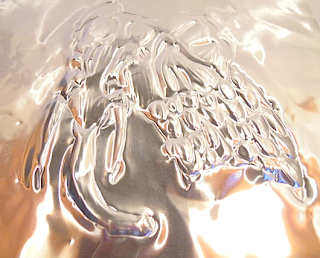For today's elephant, I decided to try repoussé with a bit of chasing. The process I used was technically different from true repoussé and chasing—mostly because I didn't have a sheet of metal thick enough to use hammers and embossing tools. Instead, I used a piece of 36-gauge aluminum, and a technique that involved a bit of repoussé and chasing, but which was ultimately more like metal embossing. The principle is similar, but the execution is easier and faster.
Repoussé and chasing are ancient techniques that involve denting metal with various implements to create a design. In repoussé, the artist works on the reverse, creating a design that will appear in low relief when flipped over. Chasing involves the exact opposite: working from the front, the image is indented, to create a design that is depressed. Most metalworking of this type employs both repoussé and chasing, to fine-tune designs and give them extra dimensionality.
When done properly—in other words, not the way I've done it—this is a relatively slow and painstaking process. The metal must be annealed (heated and tempered first), and worked patiently, so that it doesn't crack and break. The softer and more malleable the metal, the quicker you can work. Thicker sheets of metal, and harder types of metal or alloys, will take longer if you are to avoid stressing them too quickly. If you've ever bashed away at a nail and watched the head begin to split and fray at the edges, you've seen metal stress at work.
Proper repoussé and chasing also require exotic equipment such as pitch (a tar-like resin) to allow the design to sink into something with a bit of give, as well as special hammers, tools and punches. Luckily, the metal I used was soft enough that it could be indented with the kind of metal tools you'd use to sculpt clay. For my "pitch" surface, I used a piece of low-pile fleece over a piece of heavy cardboard.
The most widely used metals for this type of work are copper, tin and bronze. This is partly because a high copper content makes metals more malleable, and partly because these metals are relatively inexpensive. Gold and silver are also easy to work, but their cost makes them the kind of thing you only want to play with once you've mastered the technique.
Most people draw their designs on the back of the metal (where they'll mostly be working) with a permanent marker, bearing in mind that the final result will be reversed. I was tempted to avoid the trouble of drawing anything, just so that I could just get started. But then I saw that even artists who bang simple circles into a sheet of metal draw the circles on first.
Rather than draw something of my own today, I chose this head of an armoured war elephant, created around the time of the birth of Christ. An armoured elephant made sense to me for something worked in metal, and I liked the idea of being able to play with texture in the scales and so forth.
 |
| Fragment from a copy of a bronze sculpture, ca. 1 A.D. Collection of the Staatliche Antikensammlung, Munich |
To start, I traced the outlines of the photograph onto heavy artist-grade tracing paper. Then, rather than draw onto the aluminum, I laid the tracing on top of the aluminum, and used the end of a fine paintbrush to incise my design. This indents the pilot lines.
The next step involves flipping the aluminum over to the reverse, and using a rounded tool of some sort (I used the cap of a pen) to emboss all the outlined areas. When you flip it back over, all the areas you embossed are now raised like little pillows.
After I finished playing with all the textures, I ran a flat, round tool (actually a bottle of white-out) all around the outside edge, to make the design pop just a little more.
Elephant Fact of the Day
Although many ancient peoples used war elephants, the Romans trained them primarily as performers. Using elephants whose inherent good nature had not been ruined by war training, the Romans taught them to play cymbals, sit on giant couches in togas, and even walk tightropes. And, when Julius Caesar returned to Rome in 51 B.C., following his final victory in Gaul, there were elephants on either side of the procession, lighting the way with candelabra held in their trunks.
To Support Elephant Welfare
World Wildlife Fund
World Society for the Protection of Animals
Elephant sanctuaries (this Wikipedia list allows you to click through to information on a number of sanctuaries around the world)
Performing Animal Welfare Society





No comments:
Post a Comment